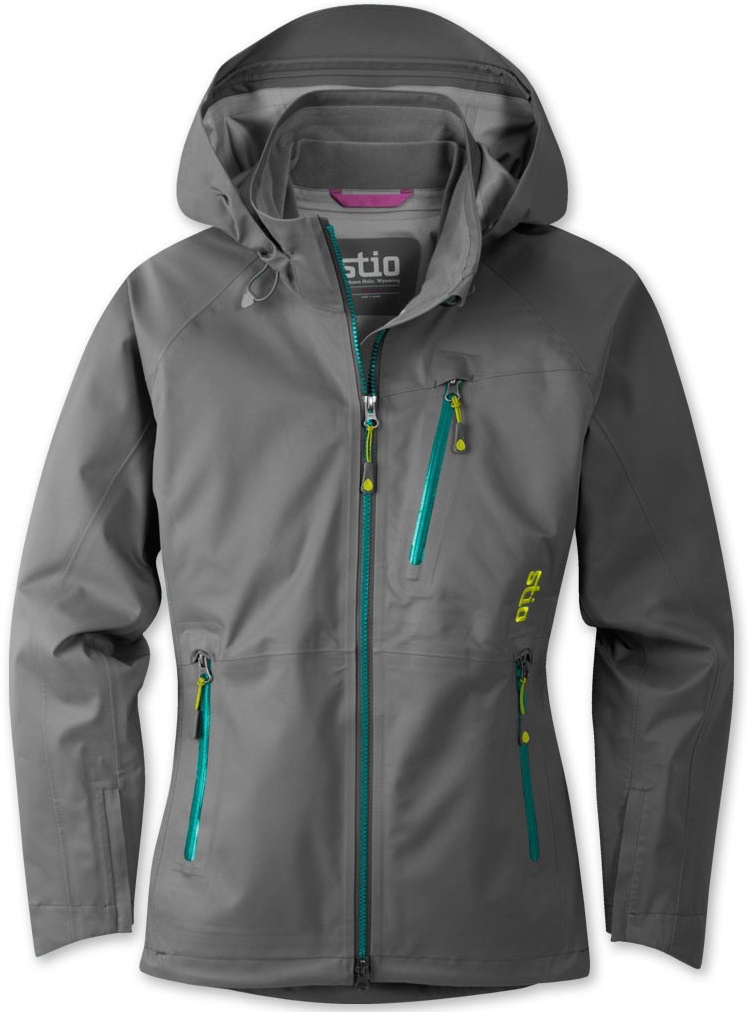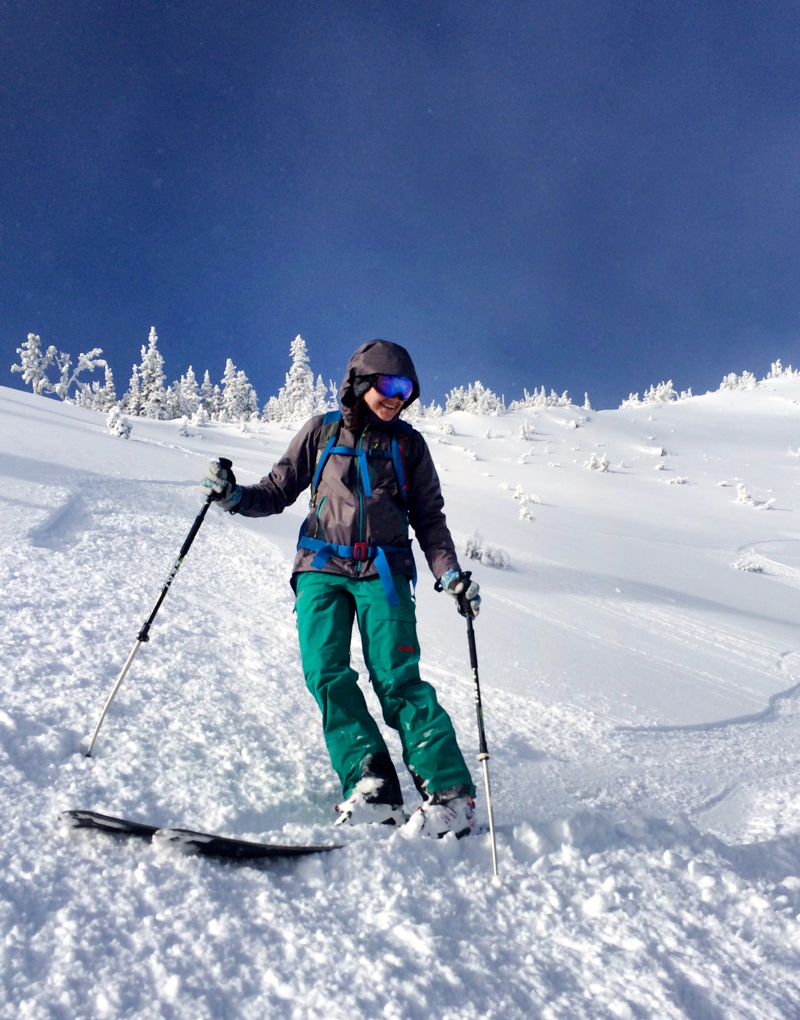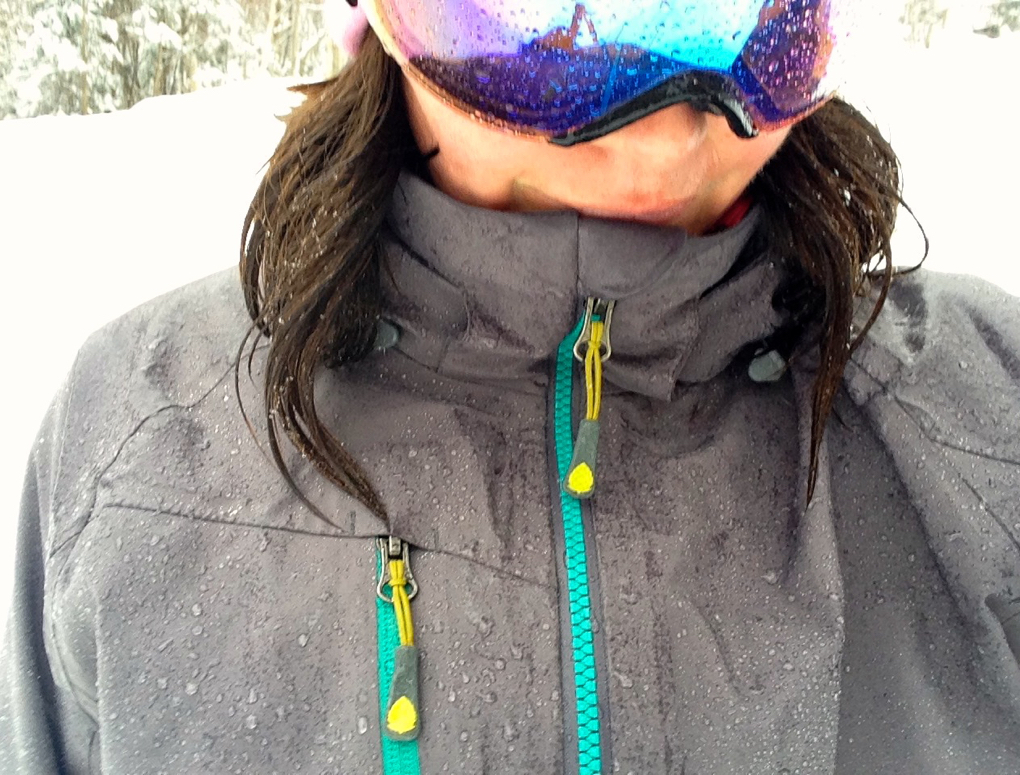
Stio Environ Jacket – Women’s
Size: Medium
Color: Eiffel Tower
Stated Weight: 15 oz
Shell Material: Brio 3-Layer fabric (PU laminate) – 10,000mm waterproof / 10,000mm breathability; 30 denier, 100% polyester, DWR treated face fabric.
Reviewer Stats: 5’6” 135 lbs
Features:
- Adjustable, removable, helmet compatible hood
- Brushed tricot collar
- Underarm vents
- YKK water-resistant Aquaguard zippers on hand and chest pockets
- YKK water-resistant Vislon center front zipper
- Internal stash pockets
- Adjustable hem with low profile cord loks
- Center back length 26 ¾”, size Medium
MSRP: $395
Days Tested: 17
Test Locations: North Cascades Backcountry; Crystal Mountain, WA; Alpental, WA; Big Sky and Bridger Bowl, MT; Sugarbush, VT
For the last few seasons I’ve been looking for the perfect ski shell; something that is sturdy and warm enough for days riding lifts, but also lightweight and technical enough to handle long days in the backcountry and ski mountaineering. And of course, I want it to look good, too. Unfortunately, these jackets usually cost a fortune, so I was quite pleased to come across the Stio Environ jacket, which suits all of my needs, yet is priced lower than a lot of 3 layer shells on the market.
Fit and Style
I’m 5’6” and 135 lbs, and size Medium in jackets usually fits me just right or is slightly big. And by “just right” I mean that the fit of the jacket leaves a little room for layering. For me, the fit of the Medium Environ is more on the “just right” end of the spectrum; it is roomy, but not too baggy. I have plenty of space in the shoulders, without feeling like I am swimming in extra material in the sleeves or at the waist. The waist is subtly fitted, which gives the jacket a more feminine look, but again, the fit of the Environ isn’t especially trim; its cut falls somewhere between a slimmer alpine fit and a relaxed freeride fit.
My only issue with the fit is that the jacket feels a bit short compared to other women’s freeride jackets I’ve worn. The Environ falls a few inches below my hips, with a drop hem in the back. I think an extra inch on the bottom would make the jacket look a little more stylish when worn with baggier pants, and would also offer more protection from the snow and rain. It’s also important to me that my jacket’s hem is long enough to fit securely below a hip belt when wearing a pack in order to prevent the jacket from riding up while hiking and skiing. There were several times that I had to keep pulling the bottom of the Environ back down under the hip belt, which was not ideal. Others with shorter torsos might have a different experience, of course.

The Environ’s sleeves reach about an inch past my wrists. While I haven’t had too much of an issue with the length, the sleeves are shorter than those on most other ski jackets I’ve worn. When I lift my hands overhead, the cuffs just barely touch my gloves. Although I’d appreciate a little more length in the sleeves, I’ve found that the subtle tapering of the fabric around the arms and the additional room in the shoulders help prevent the sleeves from riding up too much.
Fabric and Performance
The Environ uses Stio’s Brio fabric, a three-layer waterproof / breathable textile that has a PU laminate. The shell’s face fabric has a relatively light, 30 denier weave, and I was immediately impressed by how soft and supple the jacket feels. It doesn’t have the crinkly, technical feel of many hard shell jackets I’ve worn, and also doesn’t feel too thick or heavy. The fabric has a softness to it that is unlike any hard shell I’ve encountered, and feels quite luxurious.
Since the Environ’s fabric is so soft, and given its 10k waterproof rating, I wasn’t sure how much of the Pacific Northwest’s harsh, wet weather it could handle. Unfortunately, I’ve had quite a few days skiing in the rain this season, and have skied in a full downpour four or five times while wearing the Environ. For the most part, the jacket did well to keep me dry during some of the worst skiing conditions I’ve experienced, but not all.

When the Environ was brand new, the DWR coating helped water to bead up and roll off the jacket, and I stayed dry underneath. But after just a few weeks of use, if I spent a couple hours in moderate rain, the face fabric became saturated in areas and I began to feel clammy and damp in the jacket; the membrane seemed to be failing. This doesn’t come as a huge surprise, however. A piece of outerwear with a 10k waterproof rating should provide enough protection if you live somewhere like Colorado, with a dry climate and snow pack, but it would be worth looking into a jacket with Gore-Tex or Gore-Tex Pro (membranes which stand up well to harsh,very wet conditions) if you encounter rain or heavy, wet snow often.
Warmth / Layering
Strategic layering helps me regulate my body temperature while skiing, and having a good, lighter insulating piece that I can wear under a shell is key. In my experience, heavier, thicker shells can make layering more difficult, and the Environ’s lighter weight allows me to adjust my layers easily. Between 15-30ºF, wearing a wool base layer and a Primaloft insulating layer under the jacket keeps me plenty warm.
In colder temps around 5-10ºF, I needed to add an extra thick wool layer between my base layer and insulation. While I occasionally felt chilled in the Environ on such cold days, which is unsurprising given the temperature, I was impressed at how well the soft, light weight shell blocked wind and kept me warm while riding lifts.
And when the temperature jumped into the low 40s, which it has been doing quite frequently here in Washington this season, a single base layer under the Environ was very comfortable.
NEXT: Breathability and Features
